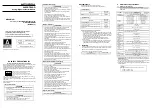
1.1 Wall Mounting
Loosen the main unit-fixing screw of the isolator to disconnect the
main unit from the socket. Next, anchor the socket onto the wall
with screws. Then, plug the main unit into the socket and secure
the main unit with the main unit-fixing screw.
29.5 or more
22±0.2
2-M4 or
2-ø4.5 or more
Mounting Dimensions
Unit: mm
59±0.3
Main unit-fixing screw
Socket
Main unit
Threaded hole for
fixing the main unit
Mounting screws
1.2 DIN Rail Mounting
Locate the isolator so that the DIN rail fits into the upper part
of the DIN-rail groove at the rear of the socket, and fasten the
socket using the slide lock at the lower part of the socket.
DIN rail
DIN rail
(Rear of socket)
Slide lock
DIN rail
Fit into here
Push
1.3 Mounting Using a Multi-mounting Base
For mounting using a multi-mounting base, see the Instruction
Manual for VJCE (VJ Mounting Base).
1.4 Using Ducts
Wiring ducts should be installed at least 30 mm away from the top
or bottom of the main unit.
2. INSTALLATION AND ENVIRONMENTAL
CONDITIONS
•
Avoid the following environments for installation locations:
Areas with vibrations, corrosive gases, dust, water, oil,
solvents, direct sunlight, radiation, a strong electric field,
and/or a strong magnetic field, direct radiant heat
,
wind,
temperature fluctuation.
•
If there is any risk of a surge being induced into the power line
and/or signal lines due to lightning or other factors, a dedicated
lightning arrester should be used as protection for both the
product and a field-installed device.
• Use indoors at an altitude of 2000 m or less.
•
Operating temperature/humidity range: −10 to 55°C (−10
to 45°C for side-by-side mounting*)/5 to 90%RH (no
condensation)
* If the previous model (style S3.xx earlier) is installed
together, the ambient temperature is 0 to 40°C.
•
Continuous vibration: (at 5 to 9 Hz) Half amplitude of 3 mm or
less (at 9 to 150 Hz) 9.8m/s
2
or less, 1 oct/min for 90 minutes
each in the three axis directions
•
Impact: 98 m/s
2
or less, 11 ms, 3 axes, 6 directions, 3 times
each
3. EXTERNAL WIRING
WARNING
●
To avoid the risk of an electric shock, turn off the
power supply and use a tester or similar device to
ensure that no power is supplied to a cable to be
connected, before carrying out wiring work.
●
Do not operate the product in the presence of
flammable or explosive gases or vapors. To do so is
highly dangerous.
●
Use of the product ignoring the specifications may
cause overheating or damage. Before turning on
the power, ensure the following:
•
Power supply voltage and input signal value
applied to the product should meet the required
specifications.
•
The external wiring to the terminals and wiring to
ground are as specifications.
Wiring should be connected to the terminals on the socket of
the product. The terminals for external connections are of M3
screws. Use crimp-on terminal lugs for connections to the
terminals.
•
Recommended cables: A nominal cross-sectional area of
0.5 mm
2
or thicker for signal cables, and that of 1.25 mm
2
or
thicker for power cables.
Analog output
Analog output
RS-485
communication
R: Externally
connected for
current input
Shunt resistor
(Externally connected
for current input)
Power supply
10
11
3 2 1
5
6
7
8
9
11
10
8
L
+
N
–
GND
1
3
+
–
+
–
Input
+
R
–
5
2
6
5
2
Output-2 signal
9
7
Output-1 signal
ALM1
(
N.O
)
(
N.O
)
ALM2
COM
Alarm output
5
2
6
B
+
A
–
COM
CAUTION
●
Do not use output-2 for the isolated single-output type.
●
The power line and input/output signal lines should
be installed away from noise-generating sources.
Other wise accuracy cannot be guaranteed.
●
Make sure to earth ground the ground terminal
through minimum resistance. The length and
thickness of the grounding cable should be as
short and thick as possible. Directly connect the
lead from the ground terminal (terminal no. 8) of
the product to the ground. Do not carry out daisy-
chained inter-ground terminal wiring.
●
The product is sensitive to static electricity;
exercise care in operating it. Before you operate
the product, touch a nearby metal part to discharge
static electricity.
●
The use of inductance (L) loads such as auxiliary
relays and solenoid valves causes malfunction or
relay failure; always insert a CR filter or diode for
spark-removal into the line in parallel with the load.
Recommended CR
•
C: 0.5 to 1µF against contact current 1A
•
R: 0.5 to 1Ω against contact voltage 1V
●
If the ambient temperature is 50 °C or more, please
use the cable that the rated temperature is 70 °C or
more.
2
IM 77J01H07-01E
5th Edition
























